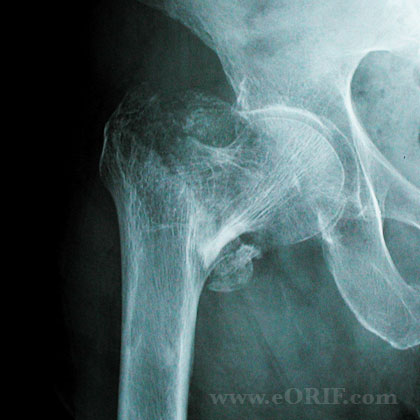

Despite its aforementioned advantages, the introduction of the TFNA implant has provoked scrutiny among members of the orthopaedic community due to a case series that described a potentially novel mode of failure. Its novel design may serve beneficial for the fixation of highly unstable 31-A3 fractures. Its titanium alloy material is purported to enhance fatigue strength and its proximal nail geometry is better suited to fit the anatomic bow of the femur. Compared to the GPFN, the TFNA nail is a newer implant, intended to represent a step up from its contemporary nails. Two of the most common cephalomedullary systems used in orthopaedic departments include the Trochanteric Fixation Nail Advanced (TFNA DePuy Synthes) and the Gamma 3 Proximal Femoral Nail (GPFN Stryker). The treatment of 31-A3 fractures is controversial, however, there is a growing body of evidence supporting the use of cephalomedullary fixation. Despite the relatively low incidence of these fractures, the incidence of implant failure is high, compared to AO/OTA 31-A1 and A2 fractures. Such a pattern results in compromise to the lateral trochanteric wall, making these fractures highly unstable and consequently, very challenging to achieve stable fixation. These fractures are characterized by a line that extends from the proximal-medial to the distal-lateral region, through the intertrochanteric-subtrochanteric region. Reverse oblique fractures are extracapsular hip fractures, classified as AO/OTA 31-A3, according to the Trauma Association classification system, and account for 5–23% of all intertrochanteric fractures. Hip fractures are increasing in incidence and are a significant source of morbidity and mortality for elderly patients. Future well-designed prospective studies are warranted to investigate the role of the TFN-A in improving outcomes for such fractures. Conclusion: The 235 mm TFN-A was associated with lower rates of cut-out compared to the short GPFN for reverse oblique intertrochanteric fractures. The frequency of revision surgeries and malunions/non-unions did not differ significantly between the two groups and additionally showed no difference in the subgroup analysis. Patients treated with the 235 mm TFN-A nail sustained lower rates of cutout, compared to 180 mm GPFN (GPFN: 6% TFN-A: 0%, p = 0.043). Results: We found no significant difference in the overall rate of complications and revisions between the two groups. A sub-group analysis was additionally performed for different nail lengths. Data were also collected for non-orthopaedic complication rates and orthopaedic complications. Data was collected on postoperative radiological variables including screw or blade location, and tip-apex distance (TAD). Patients and methods: A total of 203 patients with reverse oblique fractures (137 in the GPFN group and 66 in the TFNA group), were treated in our institution between June 2010 and May 2019. This study aimed to compare outcomes and complication rates in patients with reverse oblique fractures, treated with either TFNA or GPFN. No study has reported on outcomes with the TFN-A for reverse oblique fractures. The Gamma 3-Proximal Femoral Nail (GPFN) and the Trochanteric Fixation Nail Advanced (TFNA) are two common cephalomedullary systems used to treat this fracture. Background: Reverse oblique fractures (AO/OTA 31-A3) account for 5–23% of all intertrochanteric fractures and are challenging to manage.


 0 kommentar(er)
0 kommentar(er)
